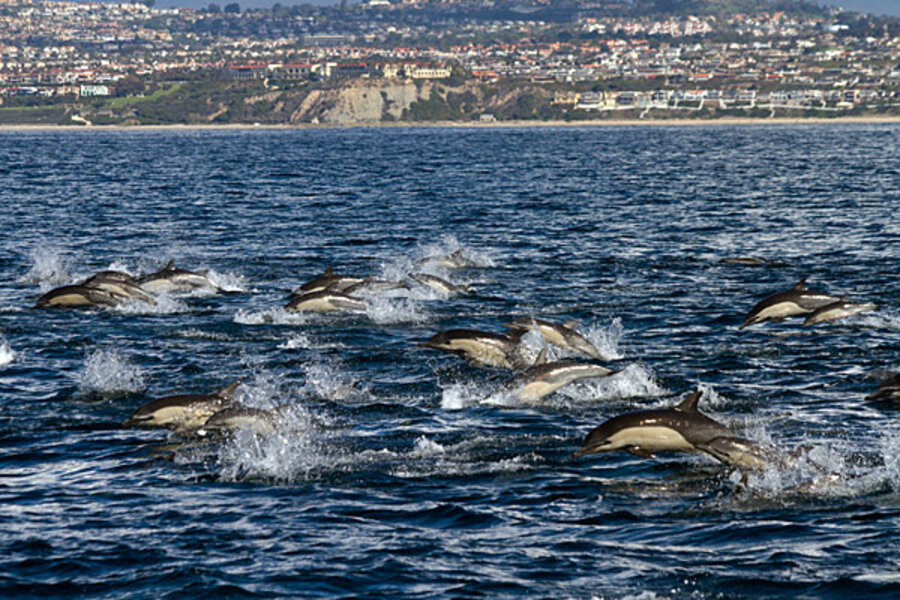Super mega dolphin pod off San Diego: Why the big party?
| Los Angeles
Are critters of the sea losing it?
Uncharacteristic feeding behavior from dolphins and whales is grabbing the attention of scientists – and the public – and so far is prompting more questions than answers about what's going on in the ocean depths.
Blue whales, which usually hang out off Costa Rica this time of year, unexpectedly showed up in California's Monterey Bay over the past week, gorging on a sizable buffet of krill. Over the weekend, a huge population of short-beaked dolphins that stretched out over 35 miles indulged in a feeding frenzy off the coast of San Diego. Last fall, sperm whales appeared uncharacteristically in Canada's Bay of Fundy. In December, rare right whales, calves in tow, showed up months earlier than usual to feed off Massachusetts' Cape Cod.
Were those thousands of dolphins who churned the coastal waters into a vast swath of sea foam just having a Presidents' Day party closer to shore than usual? Or, as some observers suggest, is all this unusual marine mammal activity a hint that some major disturbance is afoot in the oceans?
These are the kinds of big questions that scientists are reluctant to answer quickly when dramatic events occur.
Take the recent reappearance of porpoises in San Francisco Bay, after a 65-year absence.
“We like to study these long-term trends and really find out what is behind them,” says Bill Keener of Golden Gate Cetacean Research, a nonprofit organization set up to determine why porpoises suddenly returned to San Francisco after deserting the premises soon after World War II.
Most researchers concur that the ocean's hungry giants will follow the food wherever it takes them. Witness the blue whales feasting on krill in Monterey Bay. The ocean’s largest mammal consumes this tiny shrimp-like food by taking in vast gulps of seawater and forcing it back out through baleen plates at the front of its mouth.
Indeed, record supply of other food favorites, such as squid and mackerel, off both the Pacific and Atlantic coasts is attracting the whales and dolphins.
On the Atlantic coast, scientists on Cape Cod and in Canada have noted that the ocean waters are warming, which could in turn affect the food supply for these big creatures. Warmer water speeds up growth rates of phytoplankton, the foundation of the food chain. That leads to more plankton, which are eaten by smaller fish who in turn are scooped up by the larger sea creatures.
But hard science is very hard to come by linking climate change to anecdotal moments such as the unexpected offshore mega-pods of dolphins and whales, says Beth Pratt, California director of the National Wildlife Federation. “Clearly, something is going on, but what has changed about the feeding has not been thoroughly researched yet,” she says. “All these events are part of all of us saying, ‘wow, we are observing something unprecedented,' but we don’t know what it means yet.”
In the meantime, she says, observing the behavior of the planet’s top predators is meaningful even if the data are still forthcoming to help explain it. “There are important questions still to be answered such as, what does this tell us about the part of climate change that we can control,” says Ms. Pratt. “These are indicator species about the health of our oceans.”
Most of the planet is made up of ocean life, she notes. “These species are the canaries in the mines of the most important life on our planet.”





